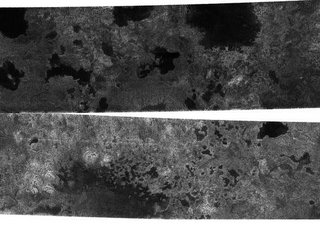 Hydrocarbon Lakes
Hydrocarbon LakesYou just know Titan had to have them:
Scientists said Monday they have found the first widespread evidence of giant hydrocarbon lakes on the surface of Saturn's planet-size moon Titan.According to the Cassini-Huygens Web Site:
The cluster of lakes was spotted near Titan's frigid north pole during a weekend flyby by the international Cassini spacecraft, which flew within 590 miles of the moon.
Researchers counted about a dozen lakes six to 62 miles wide. Some, which appeared as dark patches in radar images, were connected by channels, while others had tributaries flowing into them. Several were dried up, but the ones that contained liquid were most likely a mix of methane and ethane.
"It was a real potpourri," said Cassini scientist Jonathan Lunine of the University of Arizona.
...Last year, Cassini found what appeared to be a liquid hydrocarbon lake about the size of Lake Ontario on Titan's south pole. But the recent flyby marked the first time the spacecraft spied a multitude of lakes.
Scientists have speculated that liquid methane or ethane might form lakes on Titan, particularly near the somewhat colder polar regions. In the images, a variety of dark patches, some with channels leading in or out of them, appear. The channels have a shape that strongly implies they were carved by liquid. Some of the dark patches and connecting channels are completely black, that is, they reflect back essentially no radar signal, and hence must be extremely smooth. In some cases rims can be seen around the dark patches, suggesting deposits that might form as liquid evaporates. The abundant methane in Titan's atmosphere is stable as a liquid under Titan conditions, as is its abundant chemical product, ethane, but liquid water is not. For all these reasons, scientists interpret the dark areas as lakes of liquid methane or ethane, making Titan the only body in the solar system besides Earth known to possess lakes. Because such lakes may wax and wane over time, and winds may alter the roughness of their surfaces. Repeat coverage of these areas should test whether indeed these are bodies of liquid.
These two radar images were acquired by the Cassini radar instrument in synthetic aperture mode on July 21, 2006. The top image centered near 80 degrees north, 92 degrees west measures about 420 kilometers by 150 kilometers (260 miles by 93 miles). The lower image centered near 78 degrees north, 18 degrees west measures about 475 kilometers by 150 kilometers (295 miles by 93 miles). Smallest details in this image are about 500 meters (1,640 feet) across.
No comments:
Post a Comment